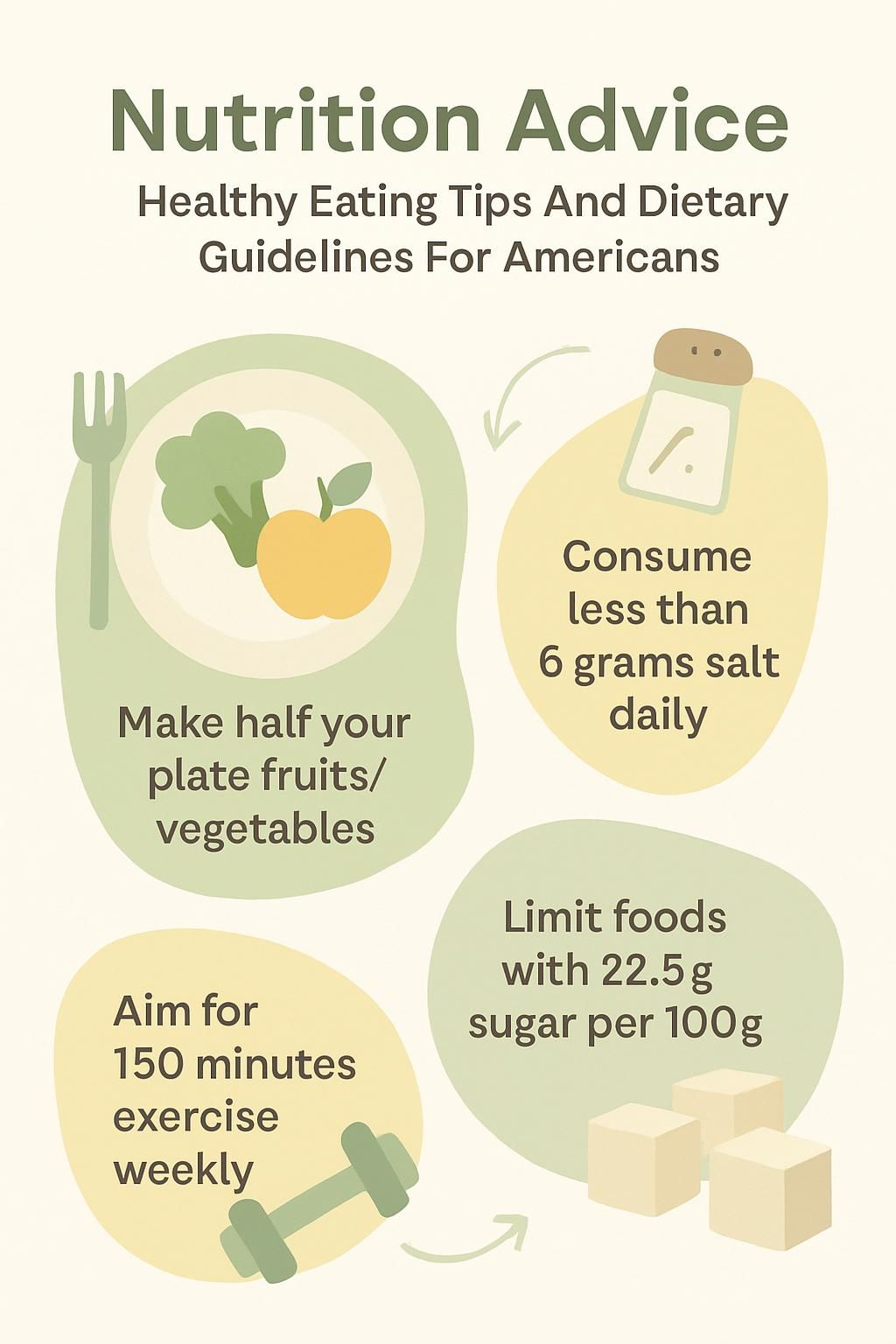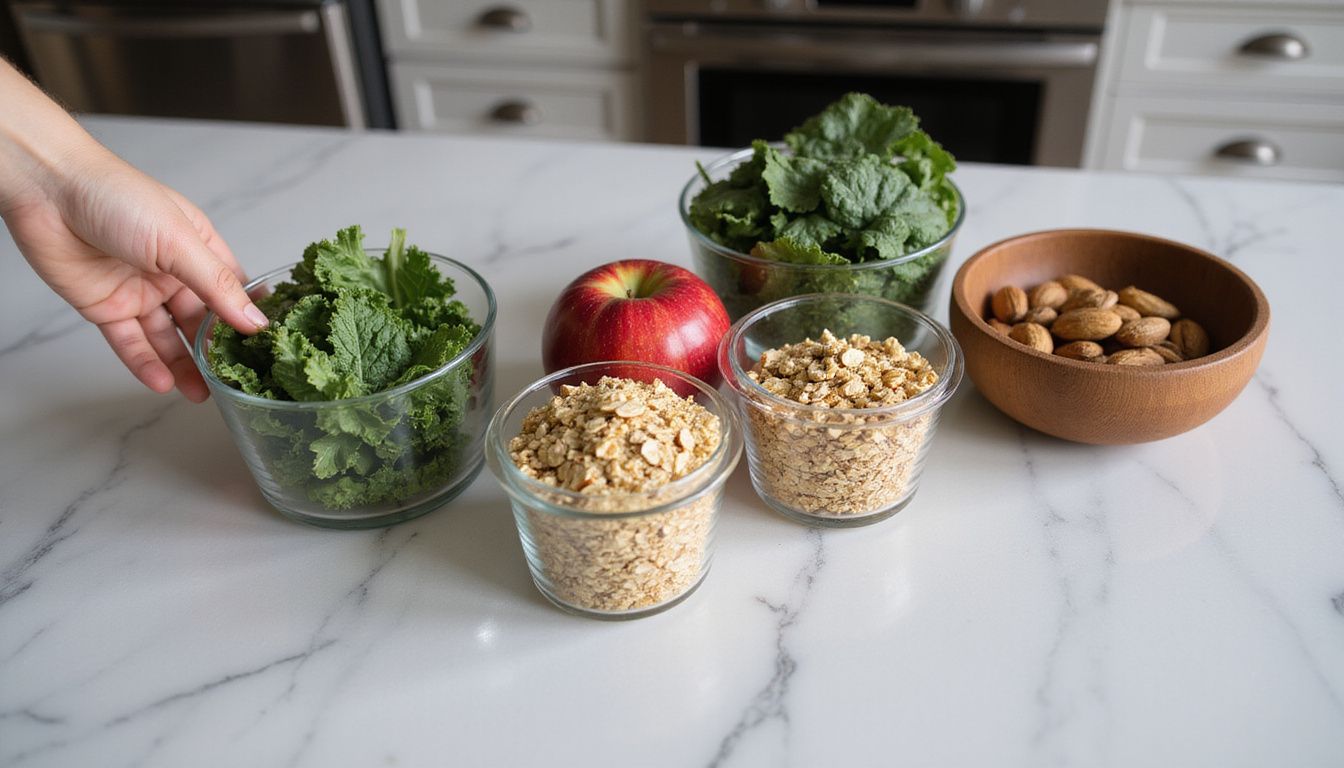Nutrition Advice: Healthy Eating Tips And Dietary Guidelines For Americans
Our Nutrition Assistant AI Suite will transform your body. You will lose fat, get toned, and build muscle. Gain confidence and optimal health.
Healthy eating can feel tough when life is busy and choices are endless. Many people in the United States fall short on fiber, calcium, vitamin D, and potassium, yet take in too much added sugars and saturated fat. This guide uses the Dietary Guidelines for Americans to offer clear steps that help you build a balanced diet and feel your best.
Key Takeaways
- Follow the Dietary Guidelines for Americans: make half your plate fruits and vegetables, choose whole grains, and limit added sugars, sodium, and saturated fat.
- Shortfall nutrients for many Americans include dietary fiber, calcium, vitamin D, and potassium. Excess intake of added sugars and saturated fat raises the risk of chronic disease.
- Aim for less than 2,300 mg of sodium per day. Keep saturated fat under 10% of daily calories, and keep added sugars under 10% as well.
- Use food labels wisely. As a quick guide, 5% Daily Value or less is low, 20% Daily Value or more is high for any nutrient.
- Combine balanced nutrition with at least 150 minutes of moderate exercise each week to lower risk of heart disease, obesity, and type 2 diabetes.

Understanding the Basics of Healthy Eating

A healthy diet fuels your body, supports a healthy weight, and helps prevent disease. Learning the food groups and key nutrients gives you the tools to make better choices each day.
Why is a balanced diet important?
A balanced diet makes it easier to get what your body needs to stay energized and well. Taking in more calories than you use can lead to weight gain. That increases your risk of type 2 diabetes, high blood pressure, heart disease, and stroke.
Limiting foods high in saturated fat, sodium, and added sugars lowers your risk of cardiovascular disease. Frameworks like USDA’s MyPlate or the UK’s Eatwell Guide can help you spread healthy choices across all food groups. Each group delivers a different mix of vitamins, minerals, fiber, and energy that your body depends on.
Good nutrition creates health in all areas of our existence. – T. Colin Campbell
Knowing how macronutrients and micronutrients work together makes daily choices simpler and smarter.
What roles do macronutrients and micronutrients play?
Macronutrients are carbohydrates, protein, and fat. They provide energy. Choose mostly whole, starchy carbohydrates like brown rice, whole grain bread, and whole wheat pasta for steady energy and more fiber. Protein supports muscles and tissue repair. Lean meats, seafood, beans, and low fat dairy are strong options.
Fat is essential, but type matters. Unsaturated fats from olive oil, canola oil, nuts, seeds, and fish help support healthy cholesterol levels.
Micronutrients are vitamins and minerals. They support growth, immunity, heart function, and strong bones. Fruits and vegetables supply vitamin C and fiber for digestion. Calcium builds bones and teeth. Milk or fortified soy and almond drinks can help meet calcium goals. Vitamin D helps your body absorb calcium. Potassium supports healthy blood pressure and is found in beans, potatoes, and leafy greens.
Falling short on micronutrients like vitamin D or potassium can raise disease risk even if total calories are high.
Key Dietary Guidelines for Americans
USDA guidance gives evidence based steps to support health and reduce risk of heart disease. These simple moves help you choose foods and drinks that work for your life.
How can I follow a healthy eating pattern at every age?
- Use MyPlate to plan meals with fruits, vegetables, whole grains, lean proteins, and dairy or fortified alternatives.
- Fill half your plate with fruits and vegetables. Choose many colors for a wider range of nutrients.
- Pick whole grains over refined grains to increase fiber and support steady blood sugar.
- Choose low fat or fat free milk or unsweetened fortified plant drinks for kids over two and adults.
- Limit saturated fat from butter and processed meats. Use vegetable oils, like olive or canola, for heart healthy fats.
- Keep added sugars and sodium low. Check labels on soups, breads, sauces, and drinks.
- Serve child sized portions. Adjust amounts to match a child’s age and appetite.
- Include legumes such as beans and lentils for affordable protein and fiber.
- Make water your main drink. It helps with weight control and dental health.
- Honor cultural traditions. Build meals with familiar flavors using nutrient dense ingredients.
- Pair healthy eating with regular physical activity for better weight and heart health.
These habits support children, teens, adults, and older adults at every life stage.
What are nutrient-dense foods and beverages?
Nutrient dense foods pack a lot of vitamins, minerals, and other helpful nutrients for relatively few calories. Fruits, vegetables, whole grains, beans, lentils, lean meats, seafood, nuts, and seeds fit this goal. Choose water, low fat milk, or unsweetened drinks instead of soda.
Use oils and spreads made with unsaturated fats, such as vegetable oils, rather than butter. The DASH eating pattern is one proven approach that favors these choices to help manage blood pressure. I swapped juice for water at breakfast, and my morning energy improved.
“Filling up on colorful fruits and vegetables every day supports a strong body more than any syrup-covered snack ever will.”
How much added sugar, saturated fat, and sodium should I limit?
Keep added sugars under 10% of daily calories. High sources include soda, sweetened coffee drinks, breakfast pastries, and candy. For children under age two, avoid added sugars.
Limit saturated fat to less than 10% of daily calories. Replace fatty cuts of meat and butter with seafood, poultry, beans, and plant oils.
Aim for less than 2,300 mg sodium per day, about one teaspoon of salt across all foods. Food labels help. As a shortcut, 5% Daily Value or less is low, 20% or more is high. Choosing more whole, unprocessed foods makes it easier to meet these targets.
Reading labels on snacks helped me spot hidden sugars and sodium I had missed before. Small swaps added up fast.
How do I support healthy eating habits for everyone?
Make the healthy choice the easy choice. Keep fruit on the counter, pre cut vegetables in the fridge, and water within reach at home, school, and work.
Use MyPlate or the Eatwell Guide as a simple visual. Offer whole grains, lean protein, nuts or seeds, and low fat dairy. Serve meals on smaller plates and check labels as a family so everyone learns portions and nutrients.
Let kids pick produce at the store or rinse vegetables for dinner. These small tasks build skills and interest. Over time, these habits support better health and weight control for all ages.
Tips for Building a Healthy Diet
Healthy eating grows from daily choices. A few small shifts can reshape your plate and your energy.
Why should I base meals on whole, unprocessed foods?
Whole foods provide more fiber, vitamins, and minerals than most packaged items. Build meals around fruits, vegetables, beans, whole grains, nuts, and seeds. This pattern helps control calories and supports heart health.
Meals based on higher fiber staples like potatoes, brown rice, whole grain bread, oats, and whole wheat pasta keep you full longer. Many processed snacks add extra sugar, sodium, and saturated fat. Replacing them with whole foods supports a low fat, nutrient rich pattern.
How can I include a variety of fruits and vegetables daily?
Aim for at least five servings each day. Variety brings different nutrients and keeps meals interesting.
- Count one serving as about 1 cup raw vegetables or fruit, or 1/2 cup cooked.
- Limit juice to a small glass, about 4 to 6 ounces. Whole fruit is usually a better choice.
- Mix colors. Rotate berries, leafy greens, citrus, peppers, and tomatoes.
- Snack on raw vegetables like carrots or celery. Add apple or orange slices for sweetness.
- Stir vegetables into soups, stews, omelets, pasta, and casseroles.
- Top yogurt or oatmeal with fruit instead of sugar or syrup.
- Keep washed fruit visible and pre cut vegetables ready to grab.
- Cover half your dinner plate with vegetables at most meals.
- Rotate choices through the week to boost potassium, fiber, and vitamin C.
- Choose canned fruit in water or its own juice and low sodium canned vegetables.
What are good lean protein sources and whole grains?
After adding more produce, round out your plate with lean proteins and whole grains. Seafood such as salmon, trout, and sardines provides protein and omega 3 fats. Aim for two seafood servings each week, including one oily fish serving.
Skinless chicken or turkey offers protein with less saturated fat. Plant proteins such as beans, lentils, tofu, tempeh, and unsalted nuts also work well. Swap white bread or pasta for brown rice, oats, or whole wheat pasta. Switching to whole grain bread kept me fuller between meals and steadied my energy.
Which healthy fats should I include in my diet?
Choose unsaturated fats most of the time. Use olive, canola, peanut, safflower, soybean, or sunflower oils in place of butter or shortening. These fats can support healthy cholesterol and lower heart disease risk, according to the American Heart Association.
Add a small handful of nuts to salads, or use avocado in place of creamy sauces. Include beans and seafood for protein that also delivers good fats. I traded creamy dressing for olive oil and vinegar, and my cholesterol numbers improved at my next checkup.
Managing Portion Sizes
Portion control is a quiet tool that protects your goals without cutting out favorite foods.
How can smaller plates help control portions?
Smaller plates make normal servings look generous, which helps you feel satisfied with less. A 9 inch plate can make a standard serving of pasta or chicken appear larger than it does on a 12 inch plate.
This visual cue supports calorie control and reduces food waste. I used to overfill large plates. After switching to smaller ones, I felt satisfied with less food and kept a steady eating pattern.
How do I read food labels and serving sizes correctly?
Labels are a map to smarter choices. A few checks make a big difference.
- Start with serving size. It shows how much counts as one serving.
- Compare nutrients using % Daily Value. Five percent or less is low, 20% or more is high.
- Choose products lower in saturated fat. Favor items with unsaturated fats instead.
- Watch added sugars. Many flavored coffees and yogurts contain more sugar than expected.
- Check calories in context. Adjust your portion if you need less than the label serving.
- Scan the ingredients list for added sugars such as corn syrup, honey, or fruit juice concentrate, and for sodium sources like monosodium glutamate.
- Compare similar items for protein, fiber, vitamins, and minerals to pick nutrient dense options.
- Practice measuring servings at home to improve your eye when dining out.
Smart Choices When Eating Out
With a few tweaks, eating out can support your goals and still taste great.
What are the healthiest grilled or baked options to choose?
Pick grilled, broiled, or baked fish, poultry, or lean cuts of meat to limit saturated fat. Skip fried items and processed meats like bacon or sausage when you can.
Ask for sauces and dressings on the side to control calories. Many sauces add over 100 calories to a meal. I order sauce separately and use just enough for flavor.
Why should I avoid sugary drinks and what are better alternatives?
Sugary drinks raise the risk of weight gain and type 2 diabetes. One can of soda adds about 150 calories and 39 grams of sugar.
Choose water first. Add fruit slices or herbs for flavor. Unsweetened tea, plain coffee, sparkling water, and low fat milk are good options. Carrying a refillable bottle helped me skip impulse sodas during the day.
Importance of Staying Hydrated
Think of water as your body’s helper. It supports digestion, temperature control, and energy.
What are the benefits of drinking water regularly?
Water supports digestion and nutrient absorption. It keeps your heart and muscles working well during activity. Adequate fluid intake also improves focus and mood.
Many adults do well with about eight cups a day, though needs vary with size and activity. Replacing sugary drinks with water supports a healthy weight and dental health.
How can I increase my daily water intake?
- Drink a glass of water with every meal and snack.
- Carry a reusable bottle and sip often.
- Set phone reminders or use a hydration app.
- Swap one sugary drink each day for water.
- Set a personal fluid goal that fits your body size and activity.
- Keep cold water ready in the fridge.
- Add fruit slices or mint for light flavor.
- Drink before you feel thirsty.
- Start the morning with a full glass.
Reducing Added Sugars and Salt
Small label savvy swaps can lower added sugars and sodium without losing flavor.
How do I identify hidden sugars and sodium in packaged foods?
Check both the Nutrition Facts label and the ingredients list. Use % Daily Value to spot highs and lows. Many packaged foods supply most of the sodium people eat each day.
Scan for sugar words such as syrup, honey, molasses, agave, dextrose, or fruit juice concentrate. I used to grab flavored yogurt each morning, then noticed honey and fruit puree high on the ingredient list. That one switch cut my added sugars quickly.
What are healthy alternatives to sugary snacks?
Choose snacks that deliver fiber, protein, and steady energy. Whole fruit, raw vegetables, plain yogurt, and unsalted nuts are great options.
Below are simple swaps to satisfy cravings with less added sugar.
| Snack Option | Nutrients Provided | Approx. Sugar |
|---|---|---|
| Raw carrot sticks, 1 cup | Fiber, vitamin A | About 3 g |
| Unsalted almonds, 1 ounce | Healthy fats, protein, magnesium | About 1 g |
| Fresh apple slices, 1 small apple | Fiber, vitamin C | About 11 g natural sugar |
| Plain Greek yogurt, 100 g | Protein, calcium | About 5 g |
Swapping high sugar snacks for whole foods helps keep added sugars within guideline limits.
Special Considerations for Different Life Stages
Nutrient needs shift with age. Paying attention to these changes helps protect growth, strength, and independence.
What are the nutrition needs for children and adolescents?
Children and teens need enough energy and nutrients to support growth. Kids under 11 should keep saturated fat lower than adults, yet children under 5 should not follow a low fat diet because their brains need energy.
Serve nutrient dense meals built from fruits, vegetables, whole grains, lean proteins, and dairy or fortified alternatives. Keep sodium modest to support healthy blood pressure later in life. I offer carrot sticks or apple slices instead of chips, and my kids enjoy both taste and crunch.
How do dietary needs change for adults and seniors?
As adults age, calorie needs often drop, but certain nutrients become more important. Fiber, calcium, vitamin D, and potassium help support digestion, bone health, and blood pressure.
Adults should limit sodium to less than 2,300 mg per day. Focus on portion control and nutrient dense foods to protect muscle and maintain a healthy weight. My grandmother improved her calcium intake by choosing low fat yogurt and leafy greens each day.
Table: Key Nutrient Needs for Adults and Seniors
| Nutrient | Why It Matters | Food Examples |
|---|---|---|
| Fiber | Supports digestion and fullness | Beans, oats, whole wheat bread |
| Calcium | Strengthens bones and teeth | Low fat yogurt, milk, fortified soy drink |
| Vitamin D | Helps absorb calcium | Fortified milk, salmon, eggs |
| Potassium | Supports heart and blood pressure | Bananas, potatoes, spinach |
Keep portions in check. Include lean proteins like chicken or fish at meals, plus plenty of vegetables.
Physical Activity and Nutrition
Food powers movement, and movement makes food work harder for you.
Why is it important to combine diet with regular exercise?
Healthy eating and exercise work best together. Cutting calories while moving more supports weight loss and long term maintenance. The CDC recommends at least 150 minutes of moderate intensity activity each week.
Activity helps your body use nutrients, boosts mood, and supports heart health. Daily walks and whole foods helped me manage my weight and feel more energetic.
What physical activities complement a healthy diet?
- Brisk walking supports heart health and weight control. Aim for 150 minutes per week.
- Swimming works the whole body with less joint stress.
- Cycling builds leg strength and cardio fitness.
- Resistance training twice weekly maintains muscle and metabolism.
- Yoga improves flexibility and reduces stress.
- Team sports add social support that keeps you active.
- Dancing turns exercise into a fun habit.
Pick activities you enjoy. Consistency beats perfection.
Role of Dietary Supplements
Supplements can fill gaps, but food first is the goal. Get advice before starting any new product.
When might dietary supplements be necessary?
Some people need extra vitamin D, calcium, iron, or vitamin B12. Reasons include little sun exposure, limited dairy, strict vegan eating, pregnancy, or trouble absorbing nutrients.
Older adults and those with osteoporosis, anemia, or digestive disorders may benefit from targeted supplements or fortified foods. National data suggest many adults do not reach adequate vitamin D from food alone. Ask a clinician which dose fits your needs.
Why should I consult a healthcare professional before using supplements?
Supplements can interact with medicines or with each other. A registered dietitian or healthcare provider can tailor guidance to your health, age, and goals.
For example, vitamin K can affect blood thinners. Many adults in the United States use supplements, and expert input helps you choose what is safe and useful for you.
The Environmental Impact of Food Choices
What you eat can support both your health and the planet.
How do plant-based diets benefit environmental sustainability?
Beans, lentils, nuts, whole grains, fruits, and vegetables usually require fewer resources than animal products. Producing plants often uses less land, energy, and water, and can reduce greenhouse gas emissions compared with livestock.
Swapping beef for beans a few times a week lowers your environmental footprint and can improve heart health. I enjoy baking with chickpea flour for a protein boost and less reliance on animal products.
What are effective ways to reduce food waste and support local farming?
- Cook with fresh or frozen produce and freeze extra portions to prevent spoilage.
- Buy in season items at farmers’ markets or join a CSA to support local growers.
- Plan a weekly menu that reuses ingredients across recipes.
- Turn leftovers into grain bowls or blend ripe fruit into smoothies. A large share of the U.S. food supply is wasted each year.
- Store foods correctly and label containers with dates.
- Choose local dairy and meat when possible to reduce transport distance.
- Compost kitchen scraps to improve soil instead of sending them to landfills.
- Shop with a list after checking pantry and fridge inventory.
- Teach portion awareness at home to cut plate waste.
These steps save money, reduce waste, and support sustainable eating.
Common Myths About Nutrition
Clear facts beat catchy myths. Use evidence to guide daily choices.
What are popular nutrition myths debunked?
Myth: All fat is bad. Truth: Unsaturated fats from avocados, nuts, olive oil, and fish can support heart health. Limit saturated fat to less than 10% of calories.
Myth: Skipping breakfast speeds weight loss. Truth: A balanced breakfast with fiber and protein can steady energy and curb cravings. Oatmeal with fruit keeps me satisfied until lunch.
Myth: All carbs are harmful. Truth: Whole grains deliver fiber and B vitamins. Choosing whole wheat bread over white provides longer lasting energy.
Why is evidence-based nutrition advice important?
Evidence based guidance uses peer reviewed studies and expert panels, such as USDA’s Dietary Guidelines and CDC resources. These groups update advice on a regular schedule to reflect new research.
Trusted facts cut through trends and confusion. Following credible recommendations helped me lower sodium and choose foods with more nutrients.
Setting Realistic Nutrition Goals
Big changes start with small, steady wins you can repeat every day.
How can I start with small, manageable nutrition changes?
Add one serving of fruit or vegetables to your day. Swap a sugary snack for an apple or plain Greek yogurt. Simple steps like these build momentum and confidence.
Carry a portable fruit for the afternoon slump. After a week, the new habit feels easy.
What are effective ways to track progress and stay consistent?
Use a simple app or a notebook to log meals, water, and activity. Tools like MyFitnessPal or the NHS 12 week weight loss plan help you track calories and movement.
Set reminders to record entries and review progress each week. Pick clear goals, such as eight cups of water a day or vegetables at lunch and dinner. Recording meals made me pause before choosing foods high in added sugar or sodium.
Celebrate small wins, like cooking dinner at home all week. Consistency beats perfect days.
Resources for Healthy Eating
Reliable tools make planning easier and help you stick with healthy eating.
What does USDA’s MyPlate guideline recommend?
MyPlate suggests you fill half your plate with fruits and vegetables, make at least half your grains whole, choose lean protein foods, and include low fat dairy or fortified alternatives. Keep added sugars, saturated fat, and sodium in check by reading labels.
Using these food groups helped me keep meals balanced without raising my grocery bill.
What online tools and apps help with meal planning?
The CDC and NHS offer free meal planning tools, printable templates, and portion guides. Apps like MyFitnessPal and Cronometer track calories, nutrients, and hydration. Many feature barcode scanners for easy logging.
USDA’s MyPlate app uses a simple plate model to plan meals. Recipe apps such as Paprika or Mealime create grocery lists based on your weekly plan.
Conclusion
Healthy eating works best when you keep it simple and consistent. Build most meals from fruits and vegetables, whole grains, lean proteins, and healthy fats. Limit added sugars, sodium, and saturated fat. Drink water often and be active most days.
Use MyPlate and the Dietary Guidelines for Americans to guide your choices. Start small, track your progress, and adjust as you learn what works for you. For personal medical advice, talk with a qualified healthcare professional. These steady steps can help you feel better today and protect your long term health.
FAQs
1. What are the main dietary guidelines for Americans?
The Dietary Guidelines for Americans recommend eating a variety of vegetables, fruits, whole grains, lean proteins such as poultry and fish, and low-fat dairy foods. Limit added sugars, sodium, and saturated fats to support heart health and maintain a healthy weight. The Centers for Disease Control and Prevention reports that most people in the United States do not meet these recommendations.
2. How can I make healthier food choices every day?
Choose nutrient-rich foods like leafy greens or berries instead of processed snacks high in sugar or salt. Plan meals ahead using grocery lists focused on fresh produce and lean meats such as turkey or salmon. A recent study from the National Institutes of Health found that meal planning increases fruit and vegetable intake by 20 percent.
3. Why is portion control important for healthy eating?
Eating proper portions helps manage calorie intake which supports weight management goals set by many adults across America. For example, using smaller plates at dinner helped me avoid overeating during family gatherings without feeling deprived.
4. Are there specific tips to help children follow healthy eating habits?
Serve balanced meals with colorful vegetables like carrots or spinach alongside protein sources such as eggs or beans; encourage water over sugary drinks; involve kids in preparing simple recipes at home to build interest in nutrition early on.
Summary: Following evidence-based dietary guidelines means choosing more fruits, vegetables, whole grains, lean proteins like chicken or seafood, while limiting added sugars and saturated fat intake each day; this approach benefits both adults’ long-term health outcomes and helps children develop lifelong good habits according to national research data.







